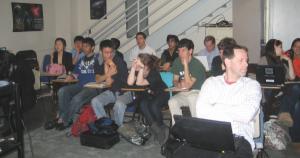Outreach Efforts at Rutgers
Quarknet
We run and maintain the very active and productive Rutgers QuarkNet Center.
Over the past three years, we have distributed twelve cosmic ray
detector kits supplied by QuarkNet to high school physics
teachers throughout New Jersey.
 The figure on the left shows
a group of teachers at one of the workshops
that we held on construction and use of the cosmic ray counters.
During the summer of 2009 we held our third annual QuarkNet-supported
Summer Research Program for High School Students. We
have found
this to be a highly effective program.
The figure on the left shows
a group of teachers at one of the workshops
that we held on construction and use of the cosmic ray counters.
During the summer of 2009 we held our third annual QuarkNet-supported
Summer Research Program for High School Students. We
have found
this to be a highly effective program.
In 2009, the summer
students constructed
a large, 1.2 m x 0.9 m, cosmic ray scintillation counter built
from scintillating bars read-out by
wavelength shifting fibers that we acquired as surplus from
the Minerva Experiment
at Fermilab.
We have enough scintillating bars on hand to construct nine
of these counters. The
counter that the students built and tested this
summer is a prototype for a large-area
array of counters,
approximately 0.1 km2 in area (300 m x 300 m), that a collaboration
of New Jersey high schools
will build, operate and analyze. It will be sensitive to the highest energy,
10^16eV, galactic cosmic
rays that are of great interest since their galactic origin is unknown.
Once the array is deployed,
students will use techniques developed by the HiRes Collaboration
to determine the impact point
of the showers and the direction of the primary cosmic rays.
 xs
This past March (see figure on the right) the students observed
cosmic ray signals from the counter and demonstrated proof
of principle. Three of the students
will continue their work during the coming school year. We plan
to construct the remaining
eight counters by spring 2010 and to deploy the array
in summer 2010. We will hold
a multi-day
workshop within the next six months to inaugurate
the program and form the
collaboration.
xs
This past March (see figure on the right) the students observed
cosmic ray signals from the counter and demonstrated proof
of principle. Three of the students
will continue their work during the coming school year. We plan
to construct the remaining
eight counters by spring 2010 and to deploy the array
in summer 2010. We will hold
a multi-day
workshop within the next six months to inaugurate
the program and form the
collaboration.
Steve Schnetzer, Yuri Gershtein and Eva Halkiadakis
as well as Ron Ransome from the Rutgers nuclear
physics group are all actively involved in this program.
We also also participated in the QuarkNet-sponsored EPPOG Hands on Particle
Physics MasterClass this past March.
Approximately twenty students with their teachers from
three schools
participated in the program. Students analyzed event displays of real data from
the Delphi detector from LEP to measure Z boson branching fractions
and then presented and discussed their
results in an international teleconference.
More about Quarknet...
Individual Faculty
-
Steve Schnetzer: heads
Rutgers Quarknet Center (2001-present), and organized
QuarkNet
Summer Research Programs (2007-2009). He organized the
MasterClass Program (2009),
and
was the banquet speaker at the Annual Meeting of the New Jersey Chapter of the
Association
of American Physics Teachers (NJAAPT) in March 2008. He arranged talks on LHC
physics by
Chris Tully (Princeton) and Nima Arkani-Hamed (IAS) at the 2008 Annual NJAAPT
Meeting,
and demonstrated cosmic rays detectors at the 2007 New Jersey Science Teachers
Convention.
He arranged talks on LHC physics at the 2008 New Jersey Science Teachers
Convention.
-
Amit Lath: judges
the Physics section of the North Jersey Regional Science Fair
(2008 - current), and helps organize science demonstrations
by high schoolers to pre-K through first grade
students (2008 - current).
-
Yuri Gershtein: presented an LHC talk to the local Society
for Physics Students (2009), and participated in
QuarkNet Summer Research Program (2009), and MasterClass Program (2009).
-
Eva Halkiadakis: presented a talk
on LHC physics at the annual NJ Science
Teachers Convention (2008), served as a panelist for a program on "Exploring
science majors at Rutgers" aimed at undergraduate
women interested in Math, Science and Engineering, and wrote a
"My Story" article for the Rutgers Office for the Promotion
of Women in Science, as well as an "explain it in 60 second" article
for Symmetry Magazine in Dec. 2006.
-
Sunil Somalwar: with Andrew Baker (astronomy), started the NSF REU
program at Rutgers, mentors REU students, and continues to advise
NJ's environmental community on energy and climate change issues.
Updated Jan 14, 2019
 The figure on the left shows
a group of teachers at one of the workshops
that we held on construction and use of the cosmic ray counters.
During the summer of 2009 we held our third annual QuarkNet-supported
Summer Research Program for High School Students. We
have found
this to be a highly effective program.
The figure on the left shows
a group of teachers at one of the workshops
that we held on construction and use of the cosmic ray counters.
During the summer of 2009 we held our third annual QuarkNet-supported
Summer Research Program for High School Students. We
have found
this to be a highly effective program.
